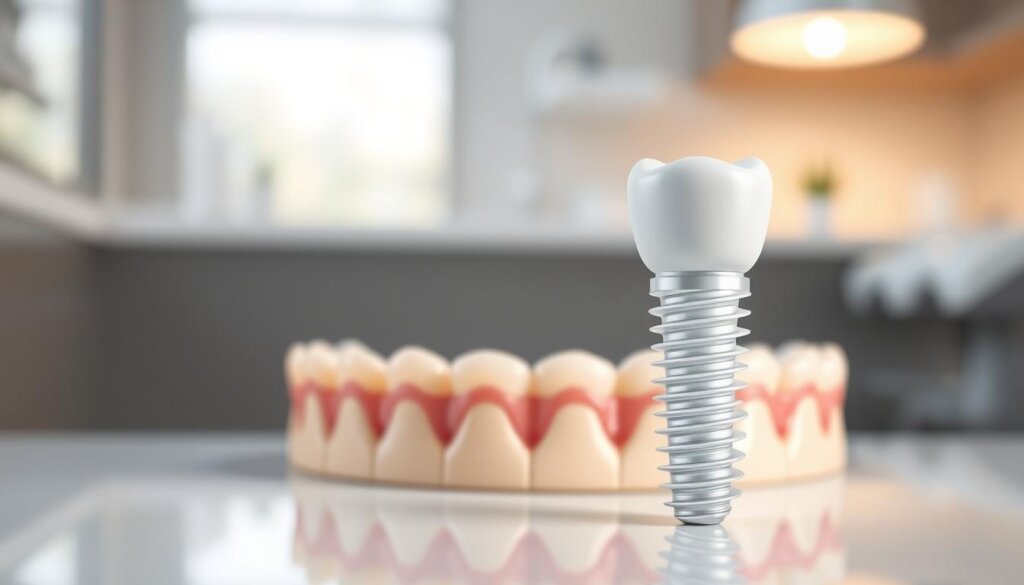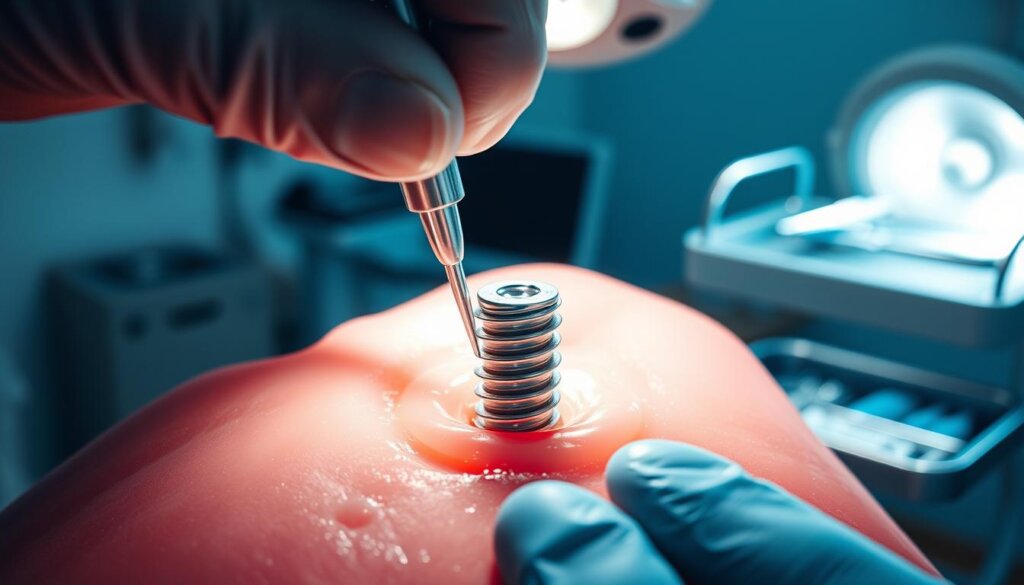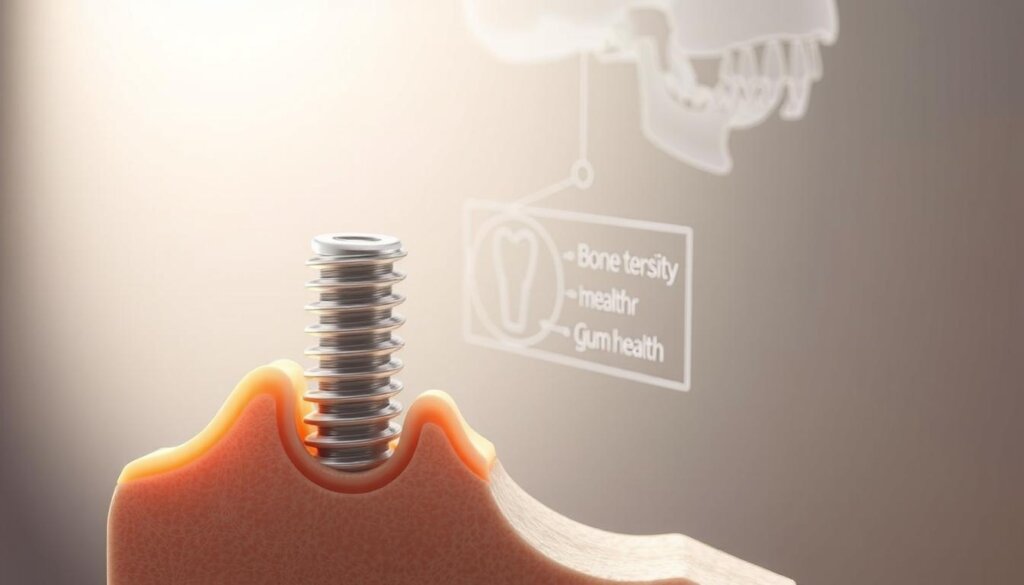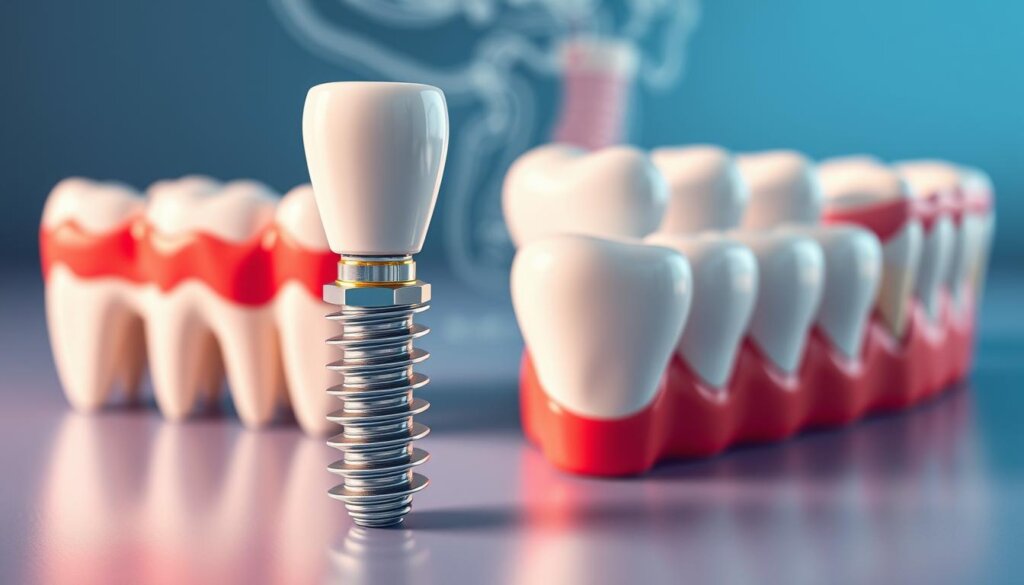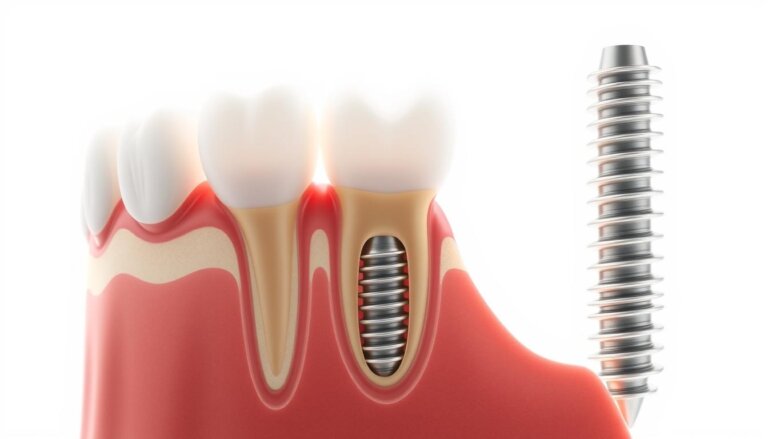How Long Have Dental Implants Been Used, and Are They Safe?
Dental implant tech has been around for over 1,400 years, starting with experiments like bamboo pegs and metal by ancient people. Today, we often wonder about how long have dental implants been used and the dental implant procedure safety. The field has made big advances to make sure implants are safe and work well for patients.
Dental implants act like the roots of natural teeth when the real ones are gone. They help you chew properly and prevent problems caused by tooth loss, such as jawbone weakening and other teeth moving. Getting dental implants can improve your life and dental health significantly.
Looking at are dental implants safe, it’s important to see how strictly they’re checked. The International Organization for Standardization (ISO) and ASTM International ensure they meet high safety standards. Talk with your dentist to understand if they’re right for you and to learn about the benefits and any risks.
Key Takeaways
- Dental implants have a long history, made safer with current technology.
- The dental implant procedure safety is judged by tough global rules.
- A detailed check-up helps decide if implants are a good idea for you.
- Implants are key in stopping jawbone loss and keeping the mouth’s shape after losing teeth.
- Think about the risks and big benefits of dental implants.
- Talking openly with a dentist you trust is crucial for making a smart choice on are dental implants safe.
A Brief History of Dental Implants
The dental implants history tells a captivating story of progress and the quest to improve health. It takes us through important times that shaped the evolution of dental implant technology.
Early Innovations in Dentistry
Early dentists tried using bone, ivory, and metals as stand-ins for missing teeth. Yet, these materials couldn’t match the real look or function of teeth. This challenge sparked groundbreaking advancements in dental restorations.
The Evolution of Dental Implants
In the mid-1900s, Per-Ingvar Brånemark, a Swedish surgeon, discovered how titanium could bond with bone. This finding was crucial for modern dental implants. The evolution of dental implant technology kicked into high gear then, improving how we treat tooth loss.
Modern Techniques and Materials
Titanium is preferred for its strength and safety, reducing risks like irritation or allergies. Digital methods have made implant procedures even more precise.
Materials like zirconium provide more options. Continuous improvements in techniques and materials reflect our dedication to better, safer dental implants. These changes highlight the advanced nature of current dental care, offering dependable solutions for missing teeth.
Types of Dental Implants
Dental implant technology has gotten way better, offering types for different needs and bone structures. Here’s a look at endosteal, subperiosteal, and zygomatic implants. They meet various patient needs well.
Endosteal Implants
Endosteal implants are the most common. They’re usually made of titanium and go right into the jawbone. They act as a base for false teeth. Endosteal implants are stable and perfect for those with a healthy jawbone.
Subperiosteal Implants
Subperiosteal implants sit on or above the jawbone, underneath the gum. They’re for patients lacking enough healthy jawbone and who don’t want bone enhancement. A frame under the gum with a post supports the new teeth.
Zygomatic Implants
Zygomatic implants, the least common, go into the cheekbone instead of the jawbone. They’re an alternative for those who can’t have endosteal implants and don’t want traditional dentures.
Finding the right implant type needs a deep look at the patient’s dental situation and jaw. The latest in dental implant tech lets doctors find and recommend the best option for great results.
| Implant Type | Description | Common Use |
|---|---|---|
| Endosteal | Implants placed in the jawbone | Ideal for patients with a good bone structure |
| Subperiosteal | Implants placed on top of the jawbone | Used when jawbone height is insufficient |
| Zygomatic | Implants embedded in the cheekbone | Suitable for severe bone loss cases |
Benefits of Dental Implants
Dental implants offer a strong way to fix oral health and make smiles beautiful. They last a long time, improving how well you can eat and talk. Both dentists and their patients often pick them as the best choice.
Dental implants can bring back the mouth’s full use. They’re put right into the jawbone. This gives a sturdy base for easy eating and talking.
They also keep your face looking young and your smile pretty. Implants stop bone loss that comes with missing teeth. This keeps the face looking fuller and more youthful.
One of the best things about implants is how long they last. Made with materials that work well with the body, they can last for many years. This makes them a great long-term solution for oral health.
How Are Dental Implants Placed?
Dental implant placement is a careful process. It ensures the procedure is safe and successful. Every step, from the first visit to recovery, is planned for the best results.
The Initial Consultation
The first step is a consultation. A dental expert checks the patient’s mouth and health history. They look at bone density, sinuses, and nerve locations. This helps plan the surgery to avoid problems and reach high success rates.
The Surgical Procedure
The main part is the surgery. The dentist puts a small titanium post into the jawbone. This acts as a strong base for the new tooth. This step is crucial for the implant and bone to fuse well, important for the implant’s long-term success and use.
Recovery and Aftercare
After the surgery, the focus is on healing and taking care of the implant. Patients must follow good oral hygiene and see their dentist often. Watching for signs of problems like swelling or infection is key. Reporting anything odd right away helps fix issues early, protecting the implant.
Knowing these steps helps patients and doctors understand the importance of each phase in dental implants. Following these steps closely improves the chance of a successful implant. This leads to better oral health and overall well-being.
Risks and Complications
Dental implants can greatly improve dental health and looks. Yet, they have risks and possible complications. Knowing these risks is crucial for both patients and doctors. It helps manage expectations and boosts the chances of success for dental implants.
Surgical complications are a big worry with risks of dental implants. They can harm nearby teeth, lead to infections, or cause nerve damage. This damage might result in pain, numbness, or tingling in the face. Implant failure is a serious issue too. It happens when the implant doesn’t properly join with the jawbone.
Long-term risks include the chance of systemic infections, which get worse with uncontrolled diabetes. These issues can cause implant failure due to poor healing and weak bones.
Dealing with addressing infection risks related to dental implants is key. Good oral hygiene and regular dentist visits help prevent infections and keep the implant intact. In some cases, doctors may give antibiotics before surgery. This helps prevent infections, especially in patients with certain health conditions or those having complex procedures.
| Complication | Symptoms | Preventive Measures |
|---|---|---|
| Surgical Infections | Swelling, pain, redness | Antibiotics, sterile surgical environment |
| Implant Failure | Loose implant, discomfort | Proper selection of implant type, precise surgical technique |
| Nerve Damage | Numbness, tingling in jaws | Careful surgical planning, imaging tests |
It’s important to keep getting care after surgery to lower risks of dental implants. Managing health conditions well can help. This ensures the implant works well and looks good.
Are Dental Implants Safe?
The safety of dental implants is a big concern for those looking to fix their smiles. There are strict rules for checking these devices. They make sure implants are safe and work well.
The FDA’s check on dental implants is very thorough. It’s all about making sure these implants do their job safely. First, they go through lots of tests to prove they’re as good as the ones we already have. One major test is to see if the implant materials are safe with our bodies.
To keep an eye on implants, getting regular dental check-ups and X-rays are suggested. This helps check how the implant is doing and if there are any issues.
Research shows that dental implants mostly work well. Many people find they can eat and talk better. They also love how their smiles look. This makes dental implants a top choice for replacing missing teeth.
| Factor | Impact on Implant Success |
|---|---|
| Biocompatibility | It’s crucial. The material must be safe and not harm body tissues. |
| FDA Approvals | This confirms the implants are safe and work as they should. |
| Patient Satisfaction | People being happy with their implants often means they work great. |
What people say about their implants backs up they are safe. Many talk about how their lives got better. But remember, everyone’s different. Certain health issues might affect how long implants last.
Factors Affecting Implant Success
Knowing what factors influence dental implants success matters a lot for patients and doctors. They aim for implants to last as long as possible. These factors range from health status to lifestyle habits and even the structure of one’s mouth.
Good oral health is key for dental implants to work. Bad oral hygiene can cause gum diseases, threatening the implant. So, checking and fixing any mouth issues is a must before getting an implant.
Lifestyle choices also affect dental implants longevity a lot. For example, smoking can slow down healing, making implants less reliable. For better success, patients should try to stop smoking before getting an implant.
The quality and amount of bone in the jaw are super important for implants. If the bone isn’t strong or big enough, doctors might need to add bone. This shows why planning before surgery and improving bone strength, if needed, is essential.
Dental Implants vs. Other Options
Looking into different ways to replace missing teeth shows big differences. Traditional methods like bridges and dentures are common. Yet, dental implants bring new benefits to the table. This helps you compare dental implants vs bridges and dental implants vs dentures, and understand the cost of dental implants.
Bridges vs. Implants
Dental implants and bridges differ mainly in one area. Implants don’t change nearby teeth, keeping more of your natural teeth intact. Bridges, though, need surrounding teeth to hold them up. This can cause issues down the line or need more dental work.
Dentures vs. Implants
Looking at dental implants vs dentures, implants act like real teeth and protect your jawbone. Dentures, which you can take out, may move around or make eating or talking hard. This can lead to less confidence and changes in how you live.
Cost Comparisons
Talking about the cost of dental implants compared to others is key. Implants may seem pricier at first. But they are cost-effective over time due to their lasting nature. Dentures and bridges need more care or replacements, but implants can last forever with the right care.
| Option | Initial Cost | Maintenance Cost | Longevity |
|---|---|---|---|
| Implants | Higher | Lower | Lifetime |
| Bridges | Moderate | Medium | 5-15 years |
| Dentures | Lower | Higher | 5-10 years |
Maintenance of Dental Implants
To make dental implants last and work well, it’s vital to take good care of them. Good maintenance boosts the dental implants success rate and keeps your mouth healthy. By having a solid care plan and seeing your dentist regularly, you can greatly improve how well your implants do.
Daily Care Routines
Daily care is key for keeping your dental implants in top shape. You should brush twice a day with a soft toothbrush and gentle toothpaste. This helps avoid scratches on your implants. Using special floss and mouthwash every day gets rid of food particles and bacteria, keeping your gums healthy.
Regular Dental Checkups
Seeing your dentist often is vital for your implants to last a long time. At these checkups, your dentist cleans your implants well and looks for any problems. Catching and treating issues early on helps keep your success rate high.
Avoiding Common Mistakes
Some habits can harm your dental implants. Smoking reduces blood flow to your gums, risking implant failure. Chewing hard things can also damage implants. Staying away from these habits helps keep your implants safe and working.
| Consideration | Recommendation |
|---|---|
| Brushing Technique | Use a soft-bristled brush, gentle strokes |
| Flossing | Daily with implant-specific floss |
| Mouthwash | Use non-alcoholic, antibacterial types |
| Professional Checkups | Every 6 months or as advised by your dentist |
| Harmful Habits | Avoid smoking and chewing hard foods |
Following these tips not only improves the dental implants success rate but also leads to a healthier mouth. With continuous care and avoiding bad habits, you can benefit from your dental implants for many years.
Who is a Good Candidate?
Finding the right candidate for dental implants is key to the success of this procedure. Age, health, and bone structure for implants are important to look at first. It’s also vital for people to think about cost considerations for dental implants and make plans.
Age and Health Considerations
To be a good fit for dental implants, a person needs a fully grown jawbone. They also must not have any health issues that would slow down bone healing. While age is not the main concern, overall health and the ability to heal after surgery are.
Bone Structure Requirements
The bone structure for implants must be dense and big enough to hold the implant. If someone doesn’t have enough bone, they might need bone grafts. This could change how long the process takes and how likely it is to work.
Financial Considerations
It’s important to understand the cost considerations for dental implants. People need to be ready for the costs of the procedure and any extra care needed afterwards. Here are the expected costs for getting dental implants:
| Initial Consultation | Procedure Cost | Post-Procedure Care |
|---|---|---|
| $100 – $500 | $1,500 – $3,000 per implant | $200 – $500 annually |
The Future of Dental Implants
The field of dental implants is getting ready for big changes. This is thanks to new steps forward in dental implant technology and bioengineering in dental implants. Both doctors and patients have a lot to look forward to.
New ideas are helping make dental implants better and nicer looking. This keeps them important for fixing teeth. Bioengineering is improving the stuff implants are made of and how they are put in.
The big focus of bioengineering in dental implants is on osseointegration. This is about how well the implant fits with the bone. Now, materials that work better with the body could make healing faster and implants last longer.
Also, future trends in tooth replacement might use 3D printing and fake bone. These could make implants fit better, place them more accurately, and lower surgery risks.
Exciting is the use of stem cells to fix bone and tissues in the mouth. This could really change outcomes for patients, especially those who don’t have enough bone for implants now.
- Implants will work better with new coatings and molecule changes.
- Patients will have an easier time with less invasive methods.
- Implants will be customized more, thanks to genetic profiles.
This look to the future shows how dental implant technology is changing. It’s moving towards treatments that are more tailored to each person and can fix teeth in new ways. By always using the latest research and ideas, the future of dental implants will change tooth replacement and improve care for patients a lot.
Dental Insurance and Implants
The connection between dental insurance and dental implants’ affordability is key for those considering this treatment. We’ll look at coverage options, procedure costs, and financing plans. These help handle the costs of dental implants.
Dental insurance for implants can vary. Some plans offer partial coverage, while others might not cover at all. It’s critical to know your insurance benefits before starting the implant process.
Coverage Options
Insurance policies differ in covering dental implant costs. Some insurers offer complete packages, including implants. Others may provide limited support or none, calling implants cosmetic. Patients should talk to their insurers to understand what is covered or not.
Understanding Costs
Getting dental implants can be expensive. Costs include the implant, abutment, and crown. These parts make the dental work functional and look good. Prices change based on materials and the dental work needed.
You can get a cost breakdown during the first visit with your dentist. This ensures you know what you’ll financially face for the procedure.
Financing Plans Available
Many dental offices work with finance companies to offer payment plans for implants. These plans might have easy installments, sometimes interest-free if paid back in time. It’s good to check these plans out. They can help spread out treatment costs without a huge financial hit.
Finding your way through dental insurance for implants can look tough at first. But, there are many resources and options out there. By really knowing your insurance coverage and looking into different financing methods, you can handle the costs. This makes improving your dental health and happiness within reach.
Frequently Asked Questions
When thinking about dental implants, people often have many questions and hear lots of myths. It’s important to know what’s real and what’s not to set the right expectations. We clear up some common myths, explain how long dental implants last, and share ways to manage any pain.
Common Myths About Implants
Many believe dental implants hurt a lot and are risky. But, thanks to better dental tech, the process is usually not very painful. Risks are low when a skilled professional does the job. Some think implants look fake. But actually, they’re made to look just like your real teeth, so no one can tell the difference.
Lifespan of Dental Implants
How long dental implants last depends on your mouth’s health, lifestyle, and overall well-being. With the right care, they can last for decades. It’s very important to keep up with dental check-ups and take good care of your mouth to make your implants last longer.
Pain Management Strategies
Managing pain right during and after getting implants is key for a good experience. The pain can usually be handled with local anesthesia and some meds after the procedure. For those who get really nervous at the dentist, sedation dentistry is an option to make the process easier.
| Myth | Fact |
|---|---|
| Implants are easily noticeable. | Implants are designed to match the look and feel of natural teeth. |
| Implants are only for the elderly. | People of all ages can benefit from dental implants, depending on their dental health. |
| Getting implants is extremely painful. | Most patients experience minimal discomfort, managed effectively with anesthesia and pain relievers. |
Conclusion
Looking back at the dental implants journey, it’s key to highlight their progress, effectiveness, and what they mean for people. The summary of dental implants shows how these tools have changed the way we fix missing teeth, giving us a strong option.
Choosing wisely about our dental health matters a lot. Knowing the good points and possible downsides of dental implants helps patients decide what’s best for them. Having a strong routine for teeth cleaning and seeing the dentist often are crucial for the implants to last and work well.
Professional guidance for dental implants is super important. From the first visit to the surgery and after, expert dentists make sure every step is done right. Their careful attention helps make sure the implants turn out well and helps keep our mouths healthy.
In summary, dental implant technology keeps getting better, but the keys to success haven’t changed. Good planning, making smart choices, and expert advice lead to great results for patients. These steps help achieve the high success rates and happiness among those choosing implants to improve their smile.
Additional Resources
Medical pros and patients can find a treasure trove of info on dental implants. Resources from trusted groups like the American Dental Association (ADA) and the American Academy of Periodontology (AAP) offer solid knowledge. They help everyone understand dental implants better.
Educational videos and webinars are great for learning too. They give expert tips and cover the latest in dental implant tech and research. This way, professionals and patients can keep up with new developments.
Joining dental implant support groups is really helpful. It’s a place where people share stories and advice. This creates a supportive community for everyone involved. Our goal is to push forward in regenerative medicine and education. We want to solve big health issues, one dental implant at a time.


